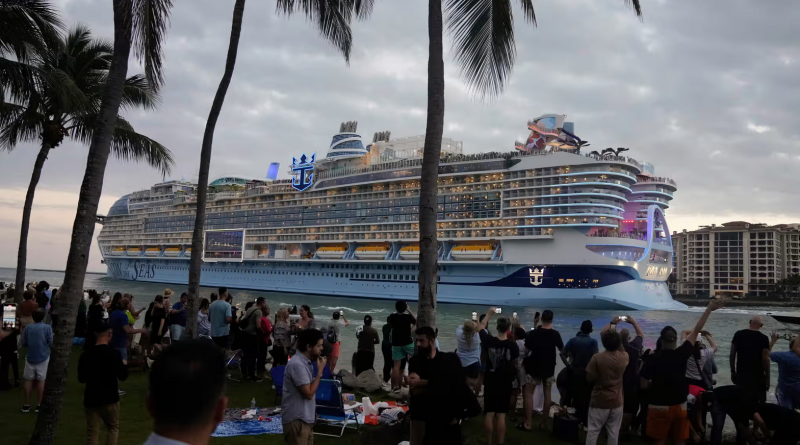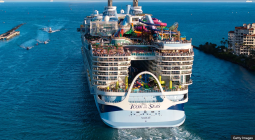‘Cruisezilla’ passenger ships have doubled in size since 2000, campaigners warn

The huge passenger vessels sometimes known as “cruisezillas” are getting bigger than ever, according to new research which has found that the world’s biggest cruise ships have doubled in size since 2000.
If the industry’s growth does not slow, the biggest ships in 2050 will be eight times larger, in terms of tonnage, than the Titanic – the largest ship on the seas before it sank a century ago, according to the campaign group Transport & Environment (T&E). The group also found that the number of cruise ships has risen 20-fold since 1970.
“Today’s cruisezillas make the Titanic look like a small fishing boat,” said Inesa Ulichina, a sustainable shipping analyst at T&E.
Industry projections suggest about 35 million passengers will travel the seas on cruise ships this year – a 6% increase from pre-pandemic levels which analysts attribute to rising wealth. Research published by JP Morgan in June found that demand for cruises “remains robust” and noted that the cruise industry had moved beyond its core market of baby boomers to increasingly attract millennials.
But the sector has a large carbon footprint, and experts struggling to clean up the industry reacted with alarm to the T&E report. Cruise ships pumped out 17% more carbon dioxide in 2022 than they did in 2019, the report found, and methane emissions rose 500% over the same time period.
Stefan Gössling, a professor at Linnaeus University in Sweden who studies tourism and the climate crisis, said cruise ships played a minor role in global tourism but that “hardly any form of tourism is more energy-intensive than cruises – specifically in combination with a flight to the point of departure”.
The report was published as European ports deal with an influx of cruise ships during a summer marred by scorching heatwaves exacerbated by the climate crisis. As residents have complained about pollution and what they see as “overtourism”, a handful of ports have cracked down on cruise ships. Barcelona has announced plans to join Amsterdam in taxing cruise visitors, who often only spend a few hours in the city, while Amsterdam has voted to close its central cruise terminal, as Barcelona did in October. Venice has banned big cruise ships from entering its damaged lagoon.
But the industry continues to boom. The world’s largest cruise ship, the Icon of the Seas, was built in Turku, Finland, and launched in January this year by Royal Caribbean. Spread across its 20 decks are 40 restaurants, seven swimming pools, a theatre and a park. The 365-metre-long vessel can carry nearly 10,000 people and is powered by liquefied natural gas (LNG) – a fuel that emits less carbon dioxide than regular marine fuel but can heat the planet more through the release of methane.
“This study demonstrates the risks of a growing cruise entertainment industry,” said Bryan Comer, who runs the marine programme at the International Council on Clean Transportation (ICCT).
Cruise ships face few engineering restrictions on their size beyond the limits of the ports in which they berth. As demand for luxury travel has boomed, operators have chased economies of scale and built bigger boats.
The total lifetime revenue that can be generated by adding extra passengers is greater than the expense of building a bigger ship and hiring more crew, said Comer. “Plus, everyone wants to have the biggest ship.”
The biggest ship in 2000 was Royal Caribbean’s Voyager of the Seas, with a gross tonnage (GT) of 137,276. Since then, the average size of the 10 largest ships has doubled from 103,000 GT to 205,000 GT.
The Cruise Lines International Association (Clia), the world’s largest cruise ship trade body, said the global cruise ship fleet was “more energy efficient than ever”, with average emissions per ship having fallen 16% in the last five years. “The vast majority of cruise ships sailing today – and scheduled to be in service well into the next decade as new ships come on line – are small to mid-size ships.”
Like planes, big ships that travel long distances cannot run on electricity because the batteries would be too heavy to carry. Experts have instead recommended they switch from burning fossil fuels to cleaner alternatives that can be synthetically produced with renewable energy.
In its roadmap for reaching net zero emissions by 2050, the International Energy Agency (IEA) expects 44% of the energy needed for international shipping to come from ammonia, followed by hydrogen (19%), biofuels (19%) and methanol (3%). These currently stand at 0% today.
With green “e-fuels” in desperately short supply, activists have criticised cruise ships and superyachts as wasteful luxuries that should be banned outright – with some staging protests at ports in Spain, France and the UK. Others have argued that the industries are so rich they should take the lead, by spurring sorely needed investment.
Although cruise lines have limited options to build fuel plants themselves, they could commit to buying the products made there, said Gössling. “But we are talking very large amounts that also require a corresponding expansion of renewable power.”
T&E called on policymakers to set up no-cruise zones in waters with fragile ecosystems and establish stricter rules for decarbonising cruise ships than non-luxury vessels. It also suggested a global tax on cruise tickets to help fund poor countries struggling to clean their economies.
Royal Caribbean did not immediately respond to a request for comment.





